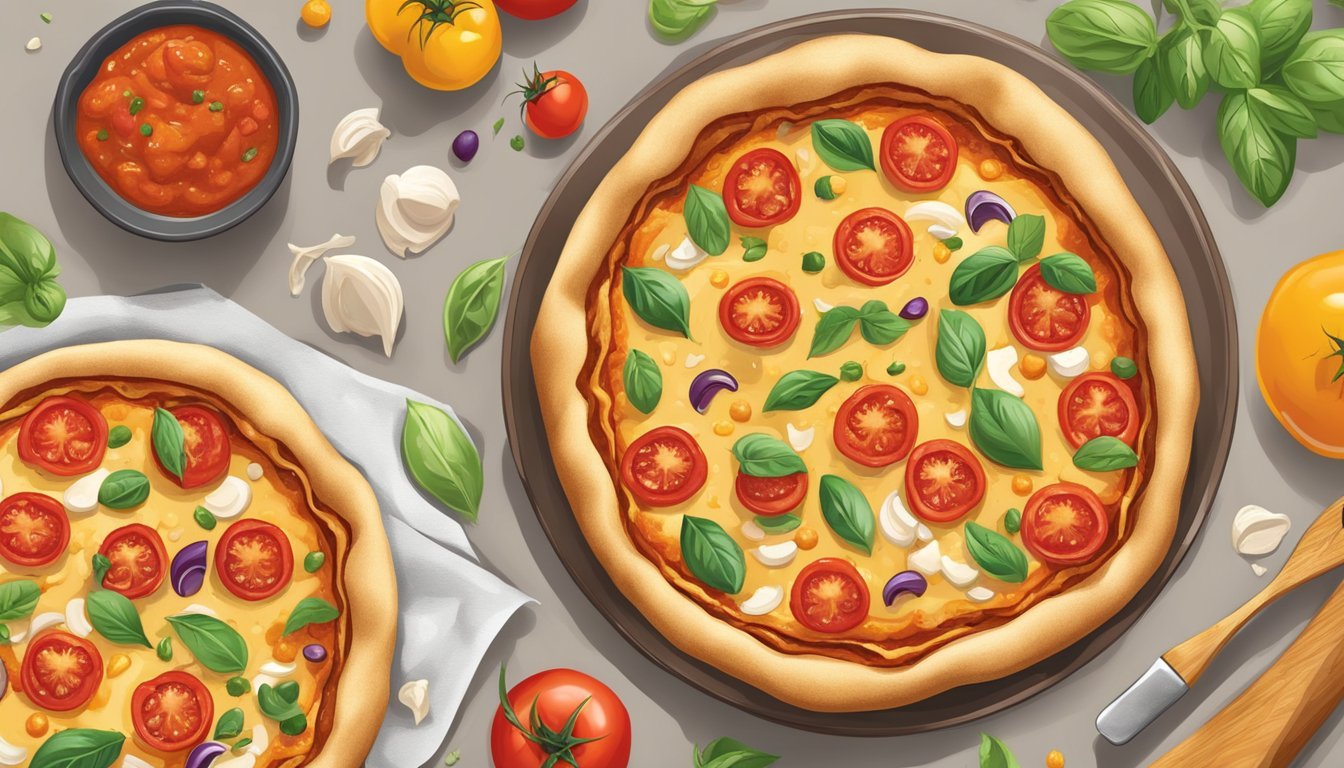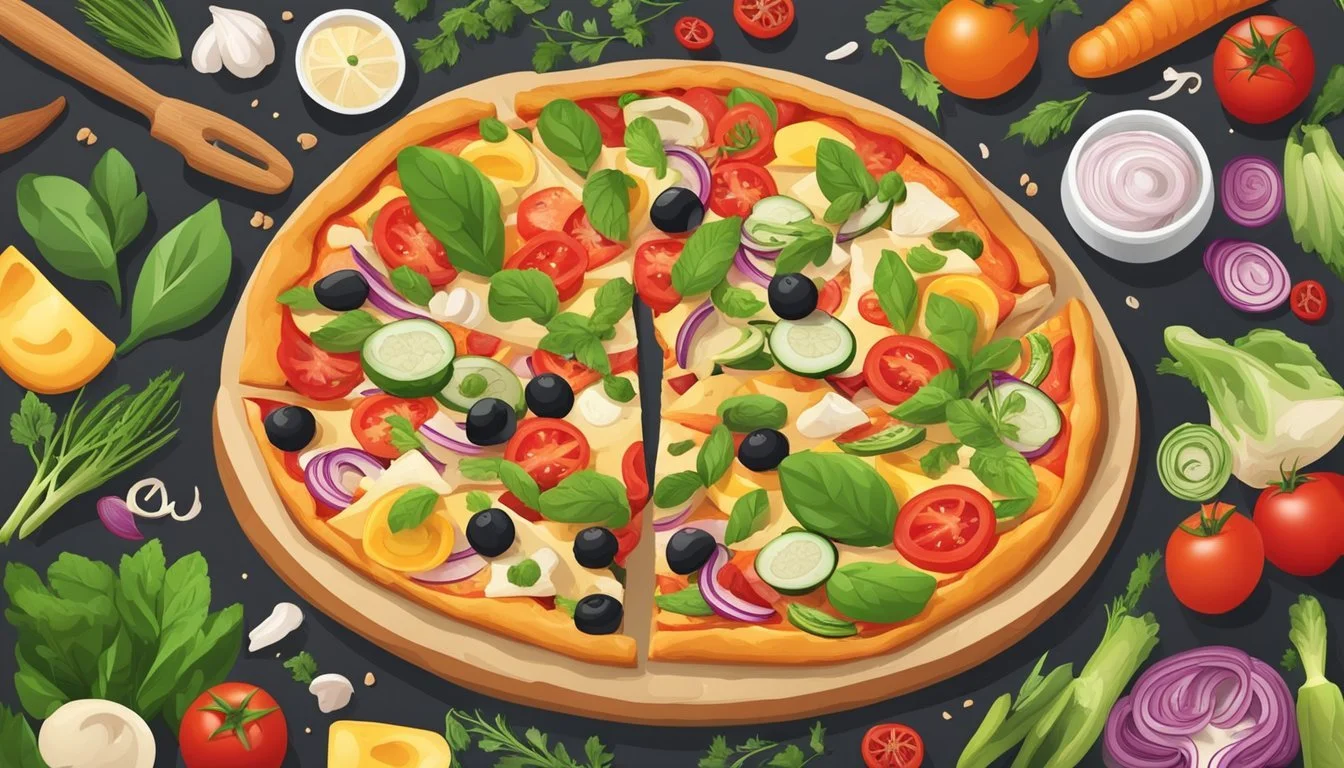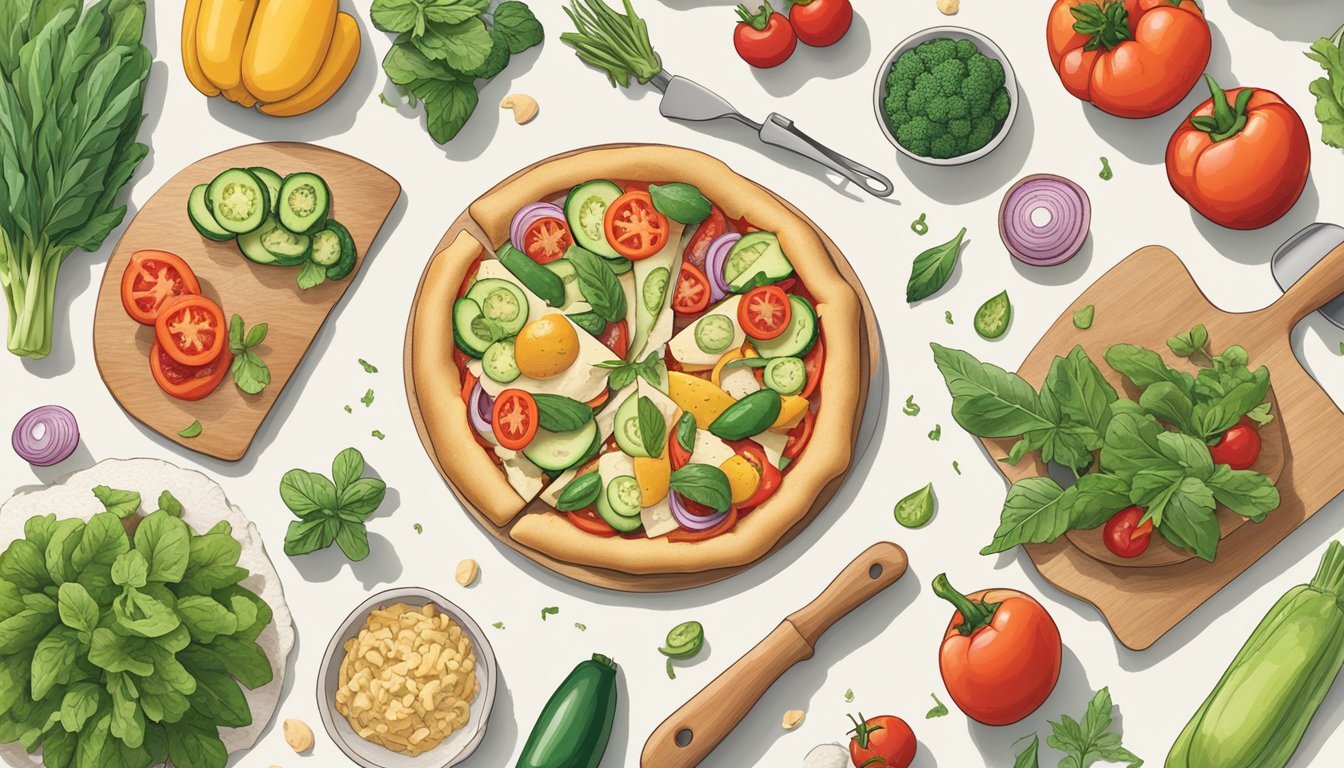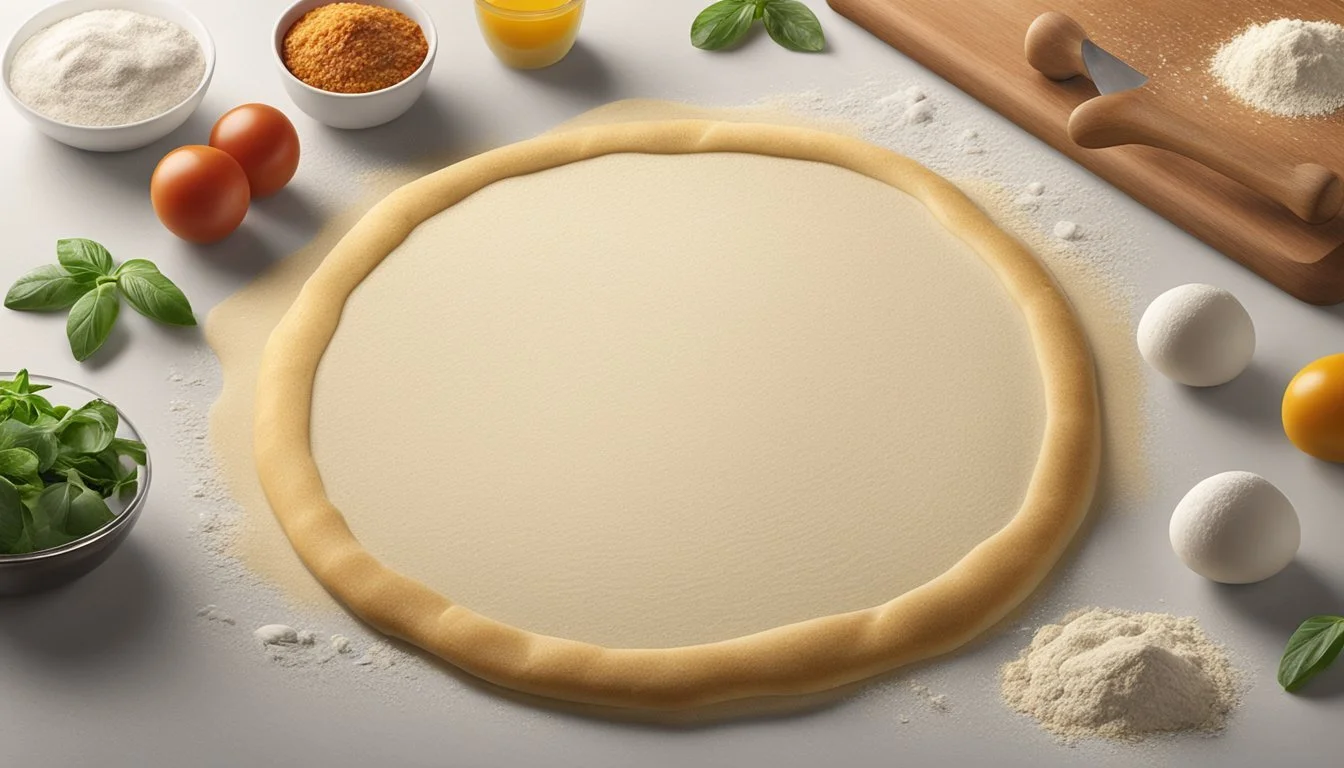Best Ever Gluten-Free Pizza Crust Recipe
Your Guide to a Perfect Pie
Discover > Healthy Living Through Food > Best Ever Gluten-Free Pizza Crust: Your Guide to a Perfect Pie
Crafting the ultimate gluten-free pizza (What wine goes well with pizza?) crust is a victory for those on a gluten-free journey who yearn for the essence of a classic pizza. Unlike traditional dough that relies on gluten for elasticity and chewiness, the pursuit of a gluten-free alternative poses a unique challenge. But fear not, as the perfect blend of flours (how long does flour last?) and savvy techniques can yield a crust that not only holds its own but also delivers a delightful chewiness and flavor, even rivaling the preferences of die-hard pizza enthusiasts or those considered the best pizza in Texas.
The secret sauce to a triumphant gluten-free pizza crust lies in mastering the alchemy of ingredients that mimic gluten's magic. Combine gluten-free flours like rice (how long does rice last?), tapioca, and sorghum (how long does sorghum last?) with binders such as xanthan gum (how long does xanthan gum last?) or psyllium husk (how long does psyllium husk last?), and voila! You've laid the foundation for a dough that possesses the coveted structure and flexibility. Hydration is key too, as gluten-free doughs tend to dry out without adequate moisture. This gluten-free pizza recipe is a testament to the fact that simplicity can lead to perfection, incorporating simple ingredients to achieve a crust that's both chewy and satisfying.
Once the dough is masterfully blended into a smooth ball, it's time to embark on the pizza-making adventure. Whether you're using a pizza oven or a conventional oven, the goal is a golden-brown crust with a delightful chewiness. After the pizza cutter works its magic, you're left with slices that hold their own against any traditional pie.
Now, imagine the joy of having leftover pizza with a chewy crust that defies the gluten-free stereotype. Store any unused portion in an air-tight container, preserving its freshness for the next pizza craving. And don't forget to personalize it with your favorite pizza toppings (What wine goes well with pizza toppings?)—fresh basil, a generous spread of tomato sauce, or any vegan pizza toppings that tickle your taste buds. With this gluten-free pizza recipe, you're not just making pizza; you're creating an experience that's as enjoyable as it is inclusive.
Understanding Gluten-Free Pizza
A gluten-free pizza offers a tasty alternative to traditional pizza for those with gluten sensitivities or celiac disease. The key to a successful gluten-free pizza lies in the choice of flour and binders to mimic the texture and elasticity of gluten.
Why Gluten-Free?
Individuals opt for gluten-free pizza due to gluten intolerance, celiac disease, or dietary preferences. Gluten, a protein found in wheat, barley (how long does barley last?), and rye, can cause health issues ranging from bloating to serious intestinal damage for those with sensitivities. Gluten-free pizza crust ensures that these individuals can enjoy pizza without adverse health effects.
Gluten-Free Flour Options
When crafting a gluten-free pizza crust, the flour blend is essential. Single flour options lack the necessary characteristics that gluten provides, hence a blend is often used:
Rice Flour: (how long does rice flour last?) Commonly used as a base, it provides a neutral flavor and light texture.
Tapioca Starch (how long does tapioca starch last?): Adds chewiness and helps in browning.
Potato Starch (how long does potato starch last?): Contributes to moisture retention for a tender crumb.
Almond Flour : Rich in protein and lends a nutty taste.
Sorghum Flour (how long does sorghum flour last?) : Offers a whole-grain, wheat-like profile.
Bow Rice Flour: Also known as sweet rice flour, it helps create a sticky, stretchy texture.
These flours are often combined to achieve the desired taste and structural integrity typically provided by gluten.
The Role of Xanthan Gum and Psyllium Husk
To replace the binding quality of gluten:
Xanthan Gum: A thickener that stabilizes and gives dough elasticity.
Psyllium Husk: A fiber that provides stretch and structure, contributing to the dough's pliability.
Both ingredients are crucial in helping gluten-free dough maintain its shape and texture during rolling, topping, and baking.
The Perfect Gluten-Free Pizza Dough
Crafting the perfect gluten-free pizza dough hinges on using the right ingredients and precise techniques to achieve a taste and texture that rivals traditional wheat-based crusts. The journey begins with a meticulous blend of gluten-free flours such as rice, tapioca, and sorghum, harmoniously combined with binders like xanthan gum or psyllium husk. Once the dough reaches the ideal consistency and forms a smooth ball on a flat surface, it's ready to be transformed into portions that will become the foundation of a gluten-free pizza masterpiece.
This carefully crafted dough is not just about meeting dietary restrictions; it's a celebration of flavor and texture. Picture each portion turning into a canvas for your culinary creativity, waiting to be adorned with your favorite pizza toppings. Whether it's a rich spread of tomato sauce, a sprinkle of fresh basil, or any other delightful additions, this gluten-free pizza dough sets the stage for a deliciously satisfying experience.
Ingredients Breakdown
The essential ingredients for gluten-free pizza dough include:
Flour: A high-quality gluten-free flour blend is the foundation. Look for blends that contain a balance of rice flour, tapioca flour (how long does tapioca flour last?), and xanthan gum to mimic the elasticity of gluten.
Warm Water: The temperature of the water is crucial. It should be around 110°F (43°C) to properly activate the yeast without killing it.
Yeast: Both active dry yeast (how long does active dry yeast last?) and instant yeast (how long does instant yeast last?) work, but they must be fresh to ensure proper leavening.
Sugar: A small amount of sugar aids in yeast activation and dough browning.
Olive Oil: Extra virgin olive oil enriches the dough, adding a subtle flavor and tenderness.
Salt: Salt provides flavor and regulates yeast activity.
Egg: Some recipes call for an egg to add structure and richness to the dough, but it can be omitted for a vegan version.
Ingredient - Purpose - Notes:
Gluten-free Flour Blend:
Purpose: Structure
Notes: Look for a balanced mix with xanthan gum.
Warm Water:
Purpose: Activate Yeast
Notes: Ideally, 110°F (43°C).
Active Yeast or Instant Yeast:
Purpose: Leavening
Notes: Must be fresh for effectiveness.
Sugar:
Purpose: Yeast Activation & Browning
Notes: Use minimally.
Olive Oil:
Purpose: Flavor & Tenderness
Notes: Extra virgin is preferable.
Salt:
Purpose: Flavor
Notes: Essential for taste.
Egg (Optional):
Purpose: Structure & Richness
Notes: Can be omitted for vegan recipes.
Mixing and Resting the Dough
Once the ingredients are assembled, they should undergo a careful mixing process:
Activate Yeast: Dissolve sugar in warm water and sprinkle in the yeast. Let it sit until it becomes frothy, indicating that the yeast is active.
Combine Dry Ingredients: In a separate bowl, whisk together the gluten-free flour blend and salt.
Mix Wet and Dry Ingredients: Make a well in the center of the dry ingredients and pour in the activated yeast mixture, olive oil, and if using, the egg. Stir until the dough begins to come together.
Rest the Dough: Gluten-free dough typically doesn't require kneading due to the lack of gluten. However, it needs to rest and hydrate. Cover the bowl with a damp cloth and let it sit at room temperature for at least 30 minutes.
The resting stage is crucial as it allows the flour to fully absorb the liquids, which is key for texture and ease of handling. After resting, the dough should be soft, pliable, and ready for forming into pizza crusts. It should then undergo a final proofing, where it rises until doubled in size, ensuring a light, airy crust once baked.
Preparation Techniques
Creating the perfect gluten-free pizza crust requires precision and patience. Careful attention to dough preparation is key to achieving the desired texture and firmness.
Kneading Gluten-Free Dough
Gluten-free pizza dough typically does not require extensive kneading, as there is no gluten to develop. However, a short kneading process is still important to ensure the ingredients are thoroughly combined. To knead, one should press the dough flat and then fold it over, repeating for a few minutes until the dough feels homogenous.
Rolling Out the Dough
When it comes to rolling out the dough, a gluten-free mixture behaves differently. Using a rolling pin with gentle, even pressure is crucial to avoid tearing. The dough should be rolled out on a flat, gluten-free floured surface to reach the desired thickness, with frequent checks to maintain a consistent shape and depth.
Using Parchment Paper for Transfer
Transferring gluten-free pizza dough to a hot oven can be a delicate task. Laying the rolled-out dough on parchment paper makes this process smoother and helps maintain the crust's shape. One can easily slide the parchment paper with the dough onto the preheated pizza stone or baking sheet.
Pre-Baking Strategies
In gluten-free pizza making, the pre-baking strategies set the foundation for the perfect crust by stabilizing the dough and determining the final texture.
Why Par-Bake?
Par-baking is the key initial step in the pizza-making process. It involves partially cooking the pizza dough before topping it. This strategy ensures stability and prevents sogginess. By doing so, the chef allows the dough a head start in the baking process, setting it up for success. Par-bake time varies but is generally between 5 to 10 minutes, depending on crust thickness and oven temperature. It is crucial to preheat the oven to 400ºF -450°F for an even par-baking process.
Perfecting Pizza Dough Thickness
Achieving the ideal thickness for gluten-free pizza dough is a delicate balance. The dough should neither be too thick nor too thin:
Thinner Crusts: Aim for approximately 1/4 inch thickness. A thin crust requires less par-bake time, often closer to the 5-minute mark, to prevent over-browning before the final bake with toppings.
Thicker Crusts: A thickness of around 1/2 inch ensures a chewier texture, and the chef should adjust the par-bake time accordingly, closer to 10 minutes.
Uniform dough thickness is essential as it directly impacts the bake time and final crust quality. Dough that's uneven may bake unevenly, with some parts potentially being undercooked or burnt.
Mastering the Baking Process
To achieve the perfect gluten-free pizza crust, understanding and controlling oven temperature and baking duration is critical. These factors greatly influence the texture and quality of the crust.
Oven Temperature Valuation
The oven should be preheated to the right temperature before baking the pizza. A pizza stone can be used to evenly distribute heat across the baking surface. Here's the optimal setup:
Oven Type: Conventional/Home Oven
Preheat Time: At least 30 minutes before baking
Temperature: 450-475°F (232-246°C)
It's imperative to allow the pizza stone to reach the desired temperature to ensure the crust becomes crispy and not soggy.
Baking Time and Texture
The duration of baking directly affects the crust's texture. Depending on the desired outcome, here are the recommended times:
Crispy Crust Texture: 12-14 minutes
Chewy Pizza Texture: 10-12 minutes
Soft & Fluffy Texture: 8-10 minutes
Use a cookie sheet or parchment paper if a pizza stone is unavailable, but adjust baking time as these materials may alter heat transfer. Rotate the pizza halfway through baking for even cooking. The crust should emerge golden brown, with a crisp exterior and a soft or chewy interior, depending on the baking time.
Toppings and Flavor Pairings
A well-crafted gluten-free pizza crust serves as the perfect foundation for a delectable array of toppings and flavor pairings. The choice of toppings can make or break the pizza experience, particularly when managing gluten sensitivities.
Choosing the Right Toppings
Selecting toppings for a gluten-free pizza requires attention to flavor balance and texture. Fresh, high-quality ingredients tend to yield the best results. Cheese is fundamental to pizza, and mozzarella is a classic choice with its mild flavor and excellent melting properties. When it comes to meats, pepperoni is a popular option, providing a spicy kick that complements the cheese. Vegetables should be chosen for their freshness and crispness to contrast the soft texture of melted cheese.
Here's a simple guide:
Cheese:
Mozzarella
Parmesan (for a sharper flavor)
Ricotta (for creaminess)
Meat:
Pepperoni
Cooked Italian sausage
Grilled chicken
Vegetables:
Bell peppers
Mushrooms
Spinach
Seasonings:
Oregano
Garlic powder (how long does garlic powder last?)
Crushed red pepper (how long does crushed red pepper last?) (for heat)
Creative Gluten-Free Combinations
Exploring creative combinations can elevate a gluten-free pizza from good to exceptional. For a twist on classic flavors, combine mozzarella with slices of ripe pear, a sprinkle of gorgonzola, and a dash of rosemary. This fusion balances the sweetness of the pear against the tang of the cheese.
For those who enjoy more robust flavors, a mix of pepperoni and sautéed mushrooms with a generous sprinkling of oregano and garlic powder brings forward the savory profile of these toppings. Adding a drizzle of olive oil can enhance the richness and depth.
Combination - Cheese - Meat/Veggie - Seasoning:
Mediterranean Delight:
Cheese: Feta, Mozzarella
Meat/Veggie: Spinach, Kalamata Olives
Seasoning: Oregano, Garlic Powder
Sweet and Savory:
Cheese: Gorgonzola, Mozzarella
Meat/Veggie: Pear, Prosciutto
Seasoning: Rosemary
The Spicy Italian:
Cheese: Parmesan, Mozzarella
Meat/Veggie: Pepperoni, Red Onion
Seasoning: Chili Flakes, Garlic Powder
Each of these combinations respects the balance of a well-constructed pizza, ensuring that the flavors harmonize with the gluten-free crust while catering to diverse palates.
Nutritional Considerations
When considering the nutritional profile of the best-ever gluten-free pizza crust, one must assess both its calorie and macronutrient content, as well as the health impacts of using gluten-free ingredients.
Calorie and Macronutrient Content
The gluten-free pizza crust typically has a comparable calorie count to traditional wheat-based crusts, with variations depending on the ingredients used. A standard slice may contain:
Calories: 150-250
Carbohydrates: 20-30g
Protein: 2-4g
Fat: 5-10g
Saturated Fat: 2-4g
Fiber: 2-3g
This composition provides a baseline understanding of the crust's energy provision and its role in daily macronutrient intake.
The Impact of Gluten-Free Ingredients on Health
Gluten-free pizza crusts are made from various alternative flours like rice, almond, or coconut, which can influence the nutritional content significantly. They typically offer:
Sodium: Moderate amounts, often lower than traditional crusts
Cholesterol: Minimal to none
Iron: Varied, depending on the fortification of flour
Potassium: Dependent on ingredients such as potato flour (how long does potato flour last?) or additives
Calcium: Sometimes enriched in gluten-free mixes
These ingredients can be beneficial for individuals with gluten sensitivity or celiac disease and offer a safe choice without compromising on essential nutrients.
Making Vegan Gluten-Free Pizza
Creating a vegan, gluten-free pizza requires carefully selecting ingredients that fulfill dietary restrictions without compromising on flavor and texture. Ensuring that the crust and toppings are free from animal products and gluten is paramount for those following a vegan and gluten-free diet.
Dairy-Free and Egg-Free Alternatives
In traditional pizza recipes, milk and eggs are often used in the dough mixture to enrich the crust. However, for a vegan and gluten-free pizza crust, these ingredients need to be replaced with plant-based and gluten-free alternatives to adhere to dietary requirements.
For the milk alternative, one can use a variety of plant-based milks, such as:
Almond milk (how long does almond milk last?)
Soy milk (how long does soy milk last?)
Coconut milk
Oat milk (how long does oat milk last?) (ensure it's gluten-free)
It's essential to choose unsweetened and unflavored varieties to avoid altering the taste of the pizza crust.
To replace eggs in the dough, consider using:
Ground flaxseeds (how long do flaxseeds last?) mixed with water (1 tablespoon of ground flaxseeds with 2.5 tablespoons of water equals one egg)
Chia seeds mixed with water (1 tablespoon of chia seeds (how long do chia seeds last?) with 2.5 tablespoons of water equals one egg)
Commercially available vegan egg replacers that are also gluten-free
These substitutes not only bind the ingredients together as eggs do but also add nutritional value to the pizza crust.
To achieve the desired elasticity and binding properties without gluten, the flour blend is critical. A combination of the following gluten-free flours and starches can be used:
Rice flour
Tapioca starch
Potato starch
Chickpea flour (how long does chickpea flour last?)
Sorghum flour (how long does sorghum flour last?)
Adding xanthan gum or guar gum (how long does guar gum last?) can help mimic gluten's structural properties, which gives the dough elasticity.
When it comes to dairy-free cheese, there are several vegan cheese options made from nuts (how long do nuts last?), soy, and other plant-based ingredients that melt well and can be used as a topping. Look for:
Cashew-based cheese
Almond-based cheese
Soy-based cheese
Ensure that the chosen cheese alternative is also free from gluten-containing additives.
By selecting the right substitutes, one can create a delicious vegan, gluten-free pizza crust that meets dietary needs while still providing a satisfying culinary experience.
Storing and Freezing Tips
Proper storage can significantly extend the freshness of gluten-free pizza crust while employing the right methods for reheating ensures that the crust maintains its quality.
Extending Shelf Life
To maximize shelf life, one should wrap the gluten-free pizza dough tightly in plastic wrap or place it in an airtight container. It can be stored in the refrigerator for up to three days. For longer storage, freezing is an effective method. To freeze the dough, wrap it in plastic and then in foil to prevent freezer burn.
In the Refrigerator: Up to 3 days
In the Freezer:
Freezer-friendly?: Yes
Duration: Up to 3 months
Reheating for Best Results
When reheating a previously frozen gluten-free pizza crust, it's important to thaw it slowly in the refrigerator overnight. Then, to restore its original texture, allow the crust to reach room temperature before reheating it in the oven at 350°F until it's heated through.
From the Refrigerator:
Preheat oven to 350°F
Reheat until warm (approximately 5-10 minutes)
From the Freezer:
Transfer to refrigerator to thaw overnight
Allow to reach room temperature
Reheat in the oven at 350°F until thoroughly warm
Gluten-Free Pizza Crust Recipe
Creating a gluten-free pizza crust is simple with the right ingredients. Individuals with gluten intolerance or celiac disease can enjoy pizza with this recipe. It yields a crispy edge and a chewy center without using traditional wheat flour.
Ingredients:
1 cup warm water (around 110°F)
1 tablespoon sugar
2 teaspoons active dry yeast
2 cups gluten-free all-purpose flour
1 teaspoon xanthan gum (if not included in the flour blend)
1 teaspoon salt
1 teaspoon baking powder (how long does baking powder last?)
2 tablespoons olive oil
1 tablespoon apple cider vinegar (how long does apple cider vinegar last?)
Instructions:
Begin by combining warm water, sugar, and yeast in a bowl. Let it sit for 5 to 10 minutes until frothy.
In a separate bowl, whisk together the gluten-free flour, xanthan gum (if needed), salt, and baking powder.
Add the olive oil and vinegar to the yeast mixture once it has activated.
Gradually mix the dry ingredients into the wet to form a dough. It should be slightly sticky.
Place dough on a piece of parchment paper. Using oiled hands, spread it into the desired shape and thickness.
Preheat the oven to 425°F (220°C) with a pizza stone or an inverted baking sheet inside.
Allow the formed dough to rest for 30 minutes. Poke any bubbles that may form with a fork.
Transfer the dough, still on parchment, to the preheated stone or baking sheet.
Bake for 10-12 minutes or until the edges begin to turn golden brown.
Remove crust from oven, add toppings, and then bake for an additional 10-15 minutes.
Tips:
Ensure the water is at the correct temperature to activate the yeast properly.
For the best texture, avoid overworking the dough.
Customize the crust with herbs or spices as preferred.
Pre-baking the crust ensures it is cooked through once the toppings are added.
Troubleshooting Common Issues
Creating the perfect gluten-free pizza crust can sometimes present challenges with dough elasticity and ensuring the crust is neither soggy nor too hard. Below are specific strategies to address these common issues.
Dough Elasticity and Rising
A key factor in achieving the right elasticity is the balance between water and flour. The gluten-free dough tends to require more hydration for elasticity since gluten-free flour absorbs more moisture. If the dough appears too dry or isn't stretching well, gradually add water until the desired consistency is reached. Conversely, if it's too sticky, add a bit more flour.
Rise time is another critical aspect. Gluten-free dough generally requires a longer rise time to help with elasticity since it lacks gluten's natural stretchiness. Ensure the dough is placed in a warm, draft-free area and allow it to rise until it's roughly doubled in size. Using high-quality yeast and giving it ample time to activate can make a significant difference in the rise and final texture of the pizza.
Avoiding a Soggy or Hard Crust
Achieving the perfect crust texture involves the correct oven temperature and baking time. Gluten-free crusts can become soggy if not pre-baked before adding toppings. Here are a few tips:
Pre-bake the crust for 10-15 minutes at a high temperature (around 450°F or 230°C) before adding any toppings.
Utilize a pizza stone or a perforated pizza pan to allow heat to distribute evenly and to wick away moisture.
For a crust that's too hard, consider these adjustments:
Ensure your oven isn't running hotter than necessary. Use an oven thermometer to confirm the temperature.
Reduce baking time slightly – gluten-free crusts can become hard if overbaked.
Brush the edges of the crust with olive oil to keep it from hardening too much.
For homemade pizza connoisseurs, troubleshooting these issues can transform their gluten-free pizza crust from good to great. It's critical to monitor the dough's elasticity and pre-baking methods to ensure a satisfying texture in every bite.












